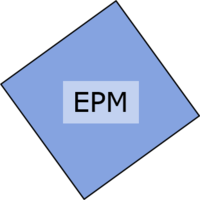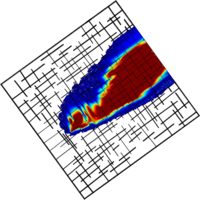Model concepts
Contents
Model concepts
For the modeling of flow and transport in fractured porous media, model concepts of different complexity have been developed. Here is an overview of the major groups.
Equivalent porous-medium model (EPM)
The equivalent porous medium model is a standard model concept for porous media with parameters averaged over control volumes. Usually, a flow model and a transport model are solved. Darcy's law is usually used to compute flow in the porous media. Contaminant transport can be modeled with the advection-dispersion equation, where different processes like sorption and degradation can be included.
Due to its simplicity and its low computational effort, the EPM model is widely used, also for fractured geologies. However, fractures are not explicitly modeled. Instead, a bulk or average hydraulic conductivity and effective diffusion or dispersion coefficients are used. This has as consequence that flow and transport in fractures and the exchange with the matrix cannot be correctly reproduced, leading to poor predictions for dual-continuum aquifers.
Dual-continuum model
A dual-continuum model uses two coupled continua. One continuum refers to the matrix and the other one to the fracture system. The basic concept is described in Gerke and Van Genuchten (1993). Balance equations for flow and transport are formulated for each continuum. Different parameters are used in the continua, f.e. porosities and conductivities specific for the fractures and for the matrix. The continua are coupled via exchange fluxes in the source and sink terms, allowing for exchange of water and substances. The quantification of these exchange fluxes is usually non-trivial. Concepts with more than two continua (f.e. Multiple INteracting Continua approach, MINC) have also been developed.
Discrete-fracture model (DFM)
The discrete-fracture model (DFM) is the most detailed approach for fracture flow and transport modeling. The (major) fractures embedded in the porous matrix are explicitly discretized. Usually, the fractures are resolved with one dimension less than the matrix (e.g. matrix in 3D, fractures in 2D). The fractures have to be characterized by properties like aperture, length, spacing, main orientation. Fractures and matrix are usually coupled at the fracture-matrix interface by flux continuity and continuity of the primary variables (hydraulic head, concentration). This is the most physically-based approach
Random-walk methods
Return to Content



